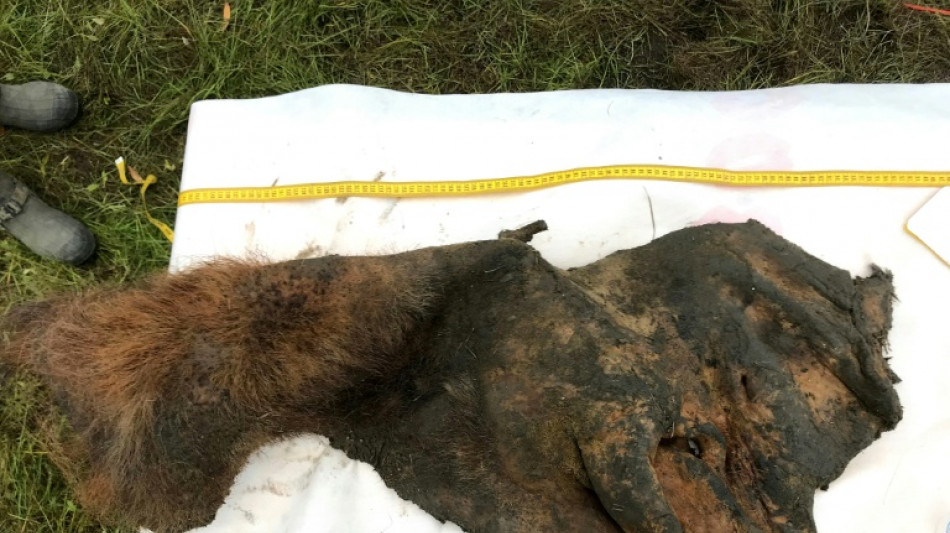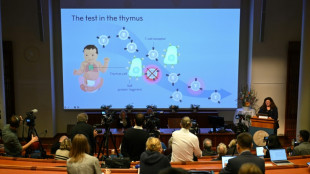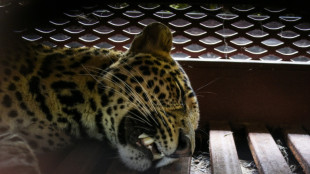
-
 Unreachable Nobel winner hiking 'off the grid'
Unreachable Nobel winner hiking 'off the grid'
-
Retirement or marketing gimmick? Cryptic LeBron video sets Internet buzzing

-
 CAF 'absolutely confident' AFCON will go ahead in protest-hit Morocco
CAF 'absolutely confident' AFCON will go ahead in protest-hit Morocco
-
Paris stocks slide amid French political upheaval, Tokyo soars

-
 EU should scrap ban on new combustion-engine sales: Merz
EU should scrap ban on new combustion-engine sales: Merz
-
US government shutdown enters second week, no end in sight

-
 World MotoGP champion Marquez to miss two races with fracture
World MotoGP champion Marquez to miss two races with fracture
-
Matthieu Blazy reaches for the stars in Chanel debut

-
 Macron gives outgoing French PM final chance to salvage government
Macron gives outgoing French PM final chance to salvage government
-
Illinois sues to block National Guard deployment in Chicago

-
 Exiled Willis succeeds Dupont as Top 14 player of the season
Exiled Willis succeeds Dupont as Top 14 player of the season
-
Hamas and Israel open talks in Egypt under Trump's Gaza peace plan

-
 Mbappe undergoing treatment for 'small niggle' at France camp: Deschamps
Mbappe undergoing treatment for 'small niggle' at France camp: Deschamps
-
Common inhalers carry heavy climate cost, study finds

-
 Madagascar president taps general for PM in bid to defuse protests
Madagascar president taps general for PM in bid to defuse protests
-
UEFA 'reluctantly' approves European league games in US, Australia

-
 Hundreds protest in Madagascar as president to announce new premier
Hundreds protest in Madagascar as president to announce new premier
-
Greta Thunberg lands in Greece among Gaza flotilla activists deported from Israel

-
 UNESCO board backs Egyptian ex-minister for top job: official
UNESCO board backs Egyptian ex-minister for top job: official
-
Facing confidence vote, EU chief calls for unity

-
 Cash-strapped UNHCR shed 5,000 jobs this year
Cash-strapped UNHCR shed 5,000 jobs this year
-
Mbappe to have 'small niggle' examined at France camp: Deschamps

-
 Brazil's Lula asks Trump to remove tariffs in 'friendly' phone call
Brazil's Lula asks Trump to remove tariffs in 'friendly' phone call
-
'Terrible' Zverev dumped out of Shanghai by France's Rinderknech

-
 What are regulatory T-cells? Nobel-winning science explained
What are regulatory T-cells? Nobel-winning science explained
-
OpenAI signs multi-billion dollar chip deal with AMD

-
 Salah under fire as Liverpool star loses his spark
Salah under fire as Liverpool star loses his spark
-
Paris stocks drop as French PM resigns, Tokyo soars

-
 ICC finds Sudan militia chief guilty of crimes against humanity
ICC finds Sudan militia chief guilty of crimes against humanity
-
Zverev dumped out of Shanghai Masters by France's Rinderknech

-
 One hiker dead, hundreds rescued after heavy snowfall in China
One hiker dead, hundreds rescued after heavy snowfall in China
-
Hundreds stage fresh anti-government protests in Madagascar

-
 Feminist icon Gisele Pelicot back in court as man appeals rape conviction
Feminist icon Gisele Pelicot back in court as man appeals rape conviction
-
US government shutdown enters second week

-
 Kasatkina ends WTA season early after hitting 'breaking point'
Kasatkina ends WTA season early after hitting 'breaking point'
-
Paris stocks drop as French PM resigns

-
 Death toll from Indonesia school collapse rises to 63
Death toll from Indonesia school collapse rises to 63
-
Medicine Nobel to trio who identified immune system's 'security guards'

-
 UN rights council launches probe into violations in Afghanistan
UN rights council launches probe into violations in Afghanistan
-
UK author Jilly Cooper dies aged 88

-
 Jilly Cooper: Britain's queen of the 'bonkbuster' novel
Jilly Cooper: Britain's queen of the 'bonkbuster' novel
-
Streaming stars' Le Mans race scores Twitch viewer record

-
 England rugby star Moody 'shocked' by motor neurone disease diagnosis
England rugby star Moody 'shocked' by motor neurone disease diagnosis
-
Leopard captured after wandering into Indonesian hotel

-
 Israel, Hamas due in Egypt for ceasefire talks
Israel, Hamas due in Egypt for ceasefire talks
-
Rescuers scramble to deliver aid after deadly Nepal, India floods

-
 Tokyo stocks soar on Takaichi win, Paris sinks as French PM resigns
Tokyo stocks soar on Takaichi win, Paris sinks as French PM resigns
-
OpenAI offers more copyright control for Sora 2 videos

-
 Australia prosecutors appeal 'inadequate' sentence for mushroom murderer: media
Australia prosecutors appeal 'inadequate' sentence for mushroom murderer: media
-
Rugby World Cup-winning England star Moody has motor neurone disease


3D genome extracted from 'freeze-dried' woolly mammoth
About 52,000 years ago, the skinned hide of a Siberian woolly mammoth was exposed to conditions so frigid that it spontaneously freeze-dried, locking its DNA fragments into place.
In a study published Thursday in the journal Cell, scientists reported using this remarkable sample to reconstruct the animal's genome in three dimensions -- a breakthrough that could yield important new insights about extinct species and even boost efforts to bring them back to life.
Until now, ancient DNA specimens have only been found in short, scrambled fragments, severely limiting the amount of information researchers could extract.
"Now we show that, at least under some circumstances, it's not just those snippets of that DNA that survive, but they survive in such a way that preserves the original arrangement," co-author Olga Dudchenko, a geneticist at Baylor College of Medicine, told AFP.
Understanding the 3D architecture of an organism's genome —- the complete set of its DNA -- is crucial for identifying which genes are active in specific tissues, revealing why brain cells think, heart cells beat, and immune cells fight disease.
It was long assumed that due to the rapid degradation of very small particles, such information would inevitably be lost to history.
But around a decade ago, an international team of scientists set out to find an ancient sample where the 3D organization of the DNA remained intact such that it could be fully reconstructed with a new analytical technique.
Their quest led them to an exceptionally well-preserved woolly mammoth sample, excavated in northeastern Siberia in 2018.
Whether the hirsute pachyderm -— a female with a distinctive mullet-style hairdo -- died naturally or was killed by humans is unknown. However, it does appear that early humans skinned her, leaving tissue around the head, neck, and left ear intact, according to Dudchenko.
- Woolly mammoth jerky -
The team hypothesizes that the skin cooled and dehydrated, transitioning into a glasslike state that trapped its molecules in place and preserved the shape of its chromosomes, or the threadlike structures that hold DNA strands.
Essentially, they had discovered a piece of freeze-dried woolly mammoth jerky.
To test the resilience of jerky, they subjected lab-made and store-bought beef jerky pieces to a series of tests simulating the kind of damage ancient samples might encounter over millennia.
"We fired a shotgun at it. We ran over it with a car. We had a former starting pitcher for the Houston Astros throw a fastball at it," said Cynthia Perez Estrada, co-author of the study and a researcher at Baylor College of Medicine and Rice University.
The jerky would break into tiny bits, shattering as dramatically as window glass at times. "But at the nano-scale, the chromosomes were intact, unchanged," said Perez Estrada in a statement.
One significant discovery from their research established that mammoths had 28 pairs of chromosomes. The finding aligns with the 28 chromosomal pairs found in elephants, the closest living relatives of mammoths, "but before this study, it was anybody's guess," said Dudchenko.
- 'Fossil chromosomes' -
The team's analysis also identified several "candidate" genes which might be responsible for what made woolly mammoths woolly -- including a gene responsible for long, thick eyelashes, and another associated with sparse sweat glands.
Erez Lieberman Aiden of Baylor College of Medicine, who co-led the team, told AFP that while the researchers' goal was not to bring mammoths back, the information they gleaned could be used for such efforts.
A Japanese team is looking at cloning woolly mammoths, while a group in the United States is aiming to create genetically "mammothized" elephants.
Within the skin, "96 percent of genes are basically in the same activity state as an elephant," said Aiden, meaning that scientists working on de-extinction could now focus on the remaining four percent.
The team now hopes that the benefit of their study will extend far beyond their special sample and open a new chapter in paleogenetics if other such "fossil chromosomes" can be found.
The Arctic permafrost remains a promising place to look, and it is also possible that mummification from ancient civilizations in warmer climates could preserve genomic structures too, according to Dudchenko.
T.Germann--VB


